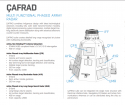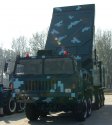In this case, it is the rumours chronicling the development of 346 from a few years back which stated that the arrays sandwiching the main central array are C band AESAs.
They were not stated as IFF arrays.
That's because the people transmitting the rumors may not be familiar with RF tech. You will have a hard time finding any missile guidance illuminator that is stripe shaped anywhere around the world. There are times when a round peg isn't going to fit into a square hole, and you have to call it out.
This is the model for the future Turkish destroyer. Like the Type 055 it has radars embedded in the deckhouse, not just one but two sets. Note it has missile target illuminators which is the one marked as AYR Sistemi. It is not shaped like a stripe. The array has to steer its beam up and down as much as left and right. For this reason, the array has to be symmetrical with an equal number of elements for the elevation as it is for the horizontal. Another thing is that arrays have to be much larger for it to have a sufficient number of elements to attain the needed level of transmission power.
Note that it also has an X-band radar on the top mast, just like the 055. But the CFR Sistemi is not used for missile guidance but is used for air and surface detection of sea skimmers at the edge of the radar horizon. The position of this radar gives it the height it needs for an extended radar horizon. My belief is that the X-band radars on the 055 is used the same way.


Last edited:




